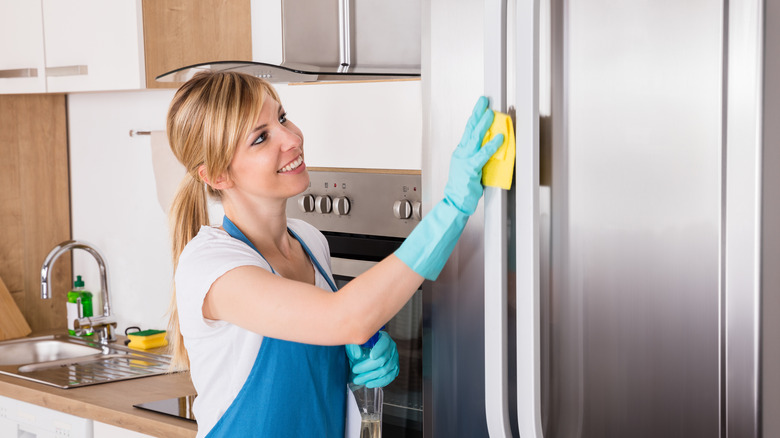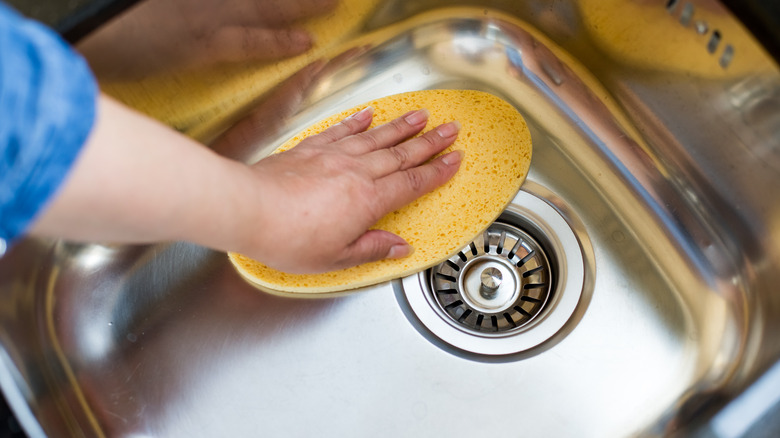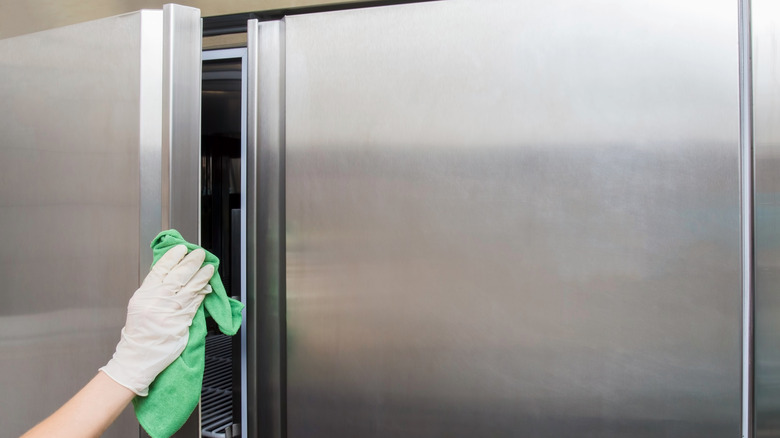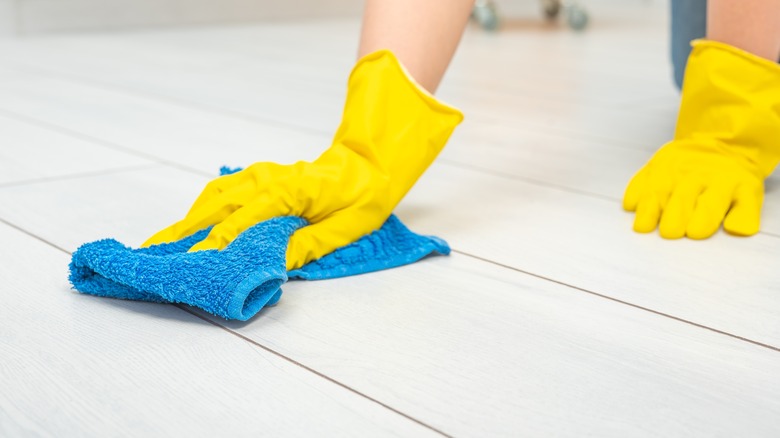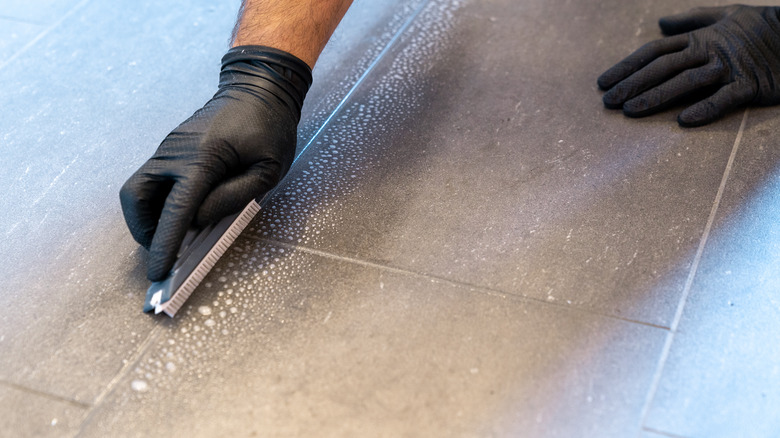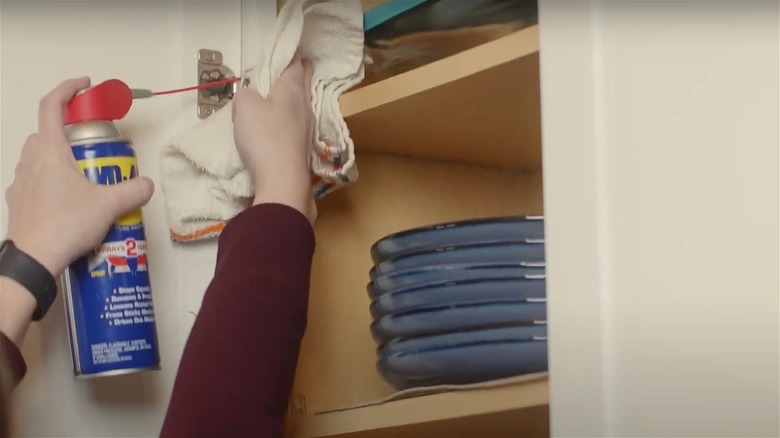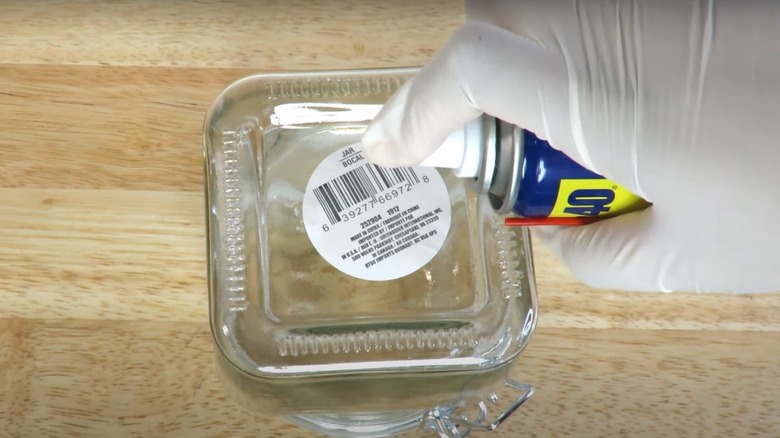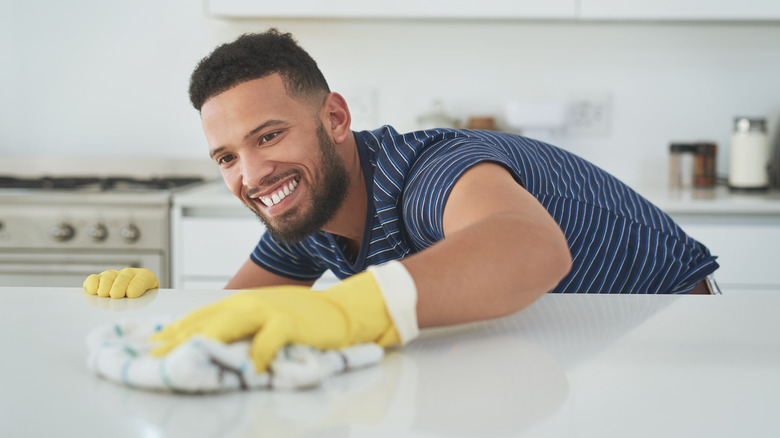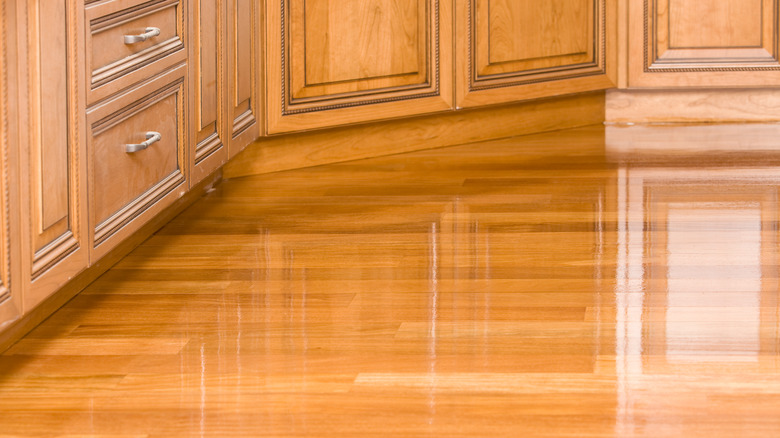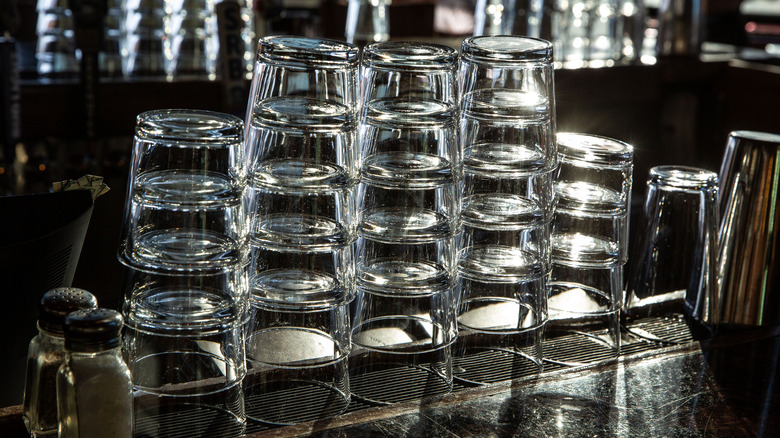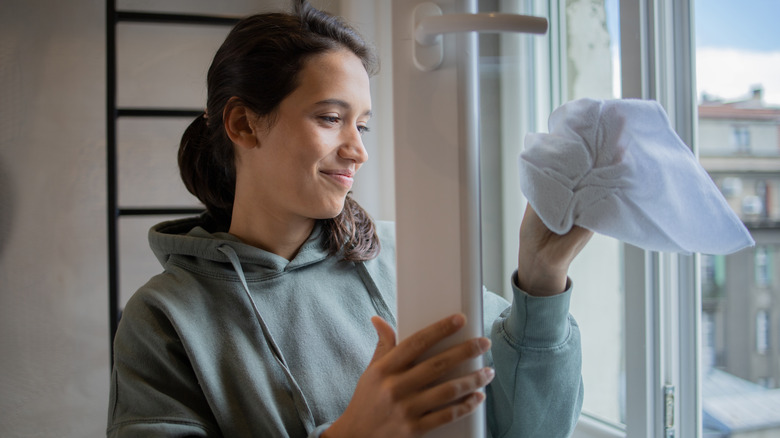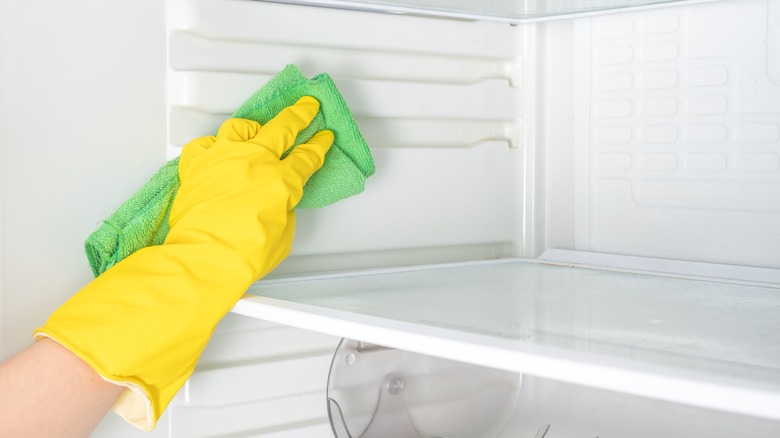Places In Your Kitchen That Could Use Some WD-40
You probably have a can or two of WD-40 in your garage or workshop that you use for various home improvements and DIY projects. While this lubricant is certainly handy for jobs such as lubricating squeaky doors, protecting your tools against rust or corrosion, or making rusted bolts or screws easier to remove, you shouldn't overlook its value in other areas of the home as well. In addition to helping you maintain your yard and clean your bathroom, WD-40 can also be a lifesaver in the kitchen.
While the exact formulation for WD-40 is kept secret by the company, it is made using a blend of different lubricants as well as other ingredients designed to fight corrosion, displace water, and ensure adequate penetration. This mix of ingredients makes it effective for a range of needs in the kitchen, from cleaning stainless steel appliances to getting that annoying sticky residue off of glass jars and containers. Read on to discover some of the many places you'll want to start using WD-40 in your kitchen. Just be warned: The product is pressurized and flammable, so you should avoid storing it anywhere near your stovetop or oven. It can also be fatal if swallowed, so be sure to remove any WD-40 residue from surfaces where you eat or prepare food.
WD-40 can help clean the kitchen sink
If you have a stainless steel kitchen sink, WD-40 might just become your new best friend when it comes to keeping it clean. Stainless sinks become dull and dirty easily, and keeping them clean isn't always easy. Fortunately, the Multi-Use version of the product can help remove food stains, grease, and rust, giving the sink a smooth and shiny appearance.
If you want to use WD-40 to clean your sink, it is best to spray it on a cloth or cleaning rag rather than directly onto the stainless steel surface. Then, wipe the rag across the sink, following the grain, to get rid of spots and stains. After you've finished cleaning the sink, rinse away the WD-40. Finally, wipe it down one more time using some warm and soapy water. This will remove the residue of the cleaner and ensure that it doesn't contaminate any pots, pans, silverware, plates, or drinkware.
It will leave your stainless steel appliances shining
WD-40 can also help you keep your stainless steel appliances clean. These surfaces always seem plagued with water droplets, fingerprints, grease, and other stains that can really make them look dirty and dingy. And, of course, the overall appearance of your kitchen suffers when your appliances aren't sparkling like they could be. Fortunately, a little bit of WD-40 can go a long way in returning their luster and shine.
As with cleaning your sink, don't spray the cleaner directly onto the surface of the appliances — doing so could leave you with streak marks. Instead, spray a little onto a cleaning rag and use it to clean the items, following their grain. With just a few wipes, the cleaner should remove greasy and other sticky residue, leaving them looking like new once again. Another benefit of using WD-40 for this task is that it can leave a protective coating to keep your dishwasher, oven door, refrigerator, and more looking cleaner for longer. Just remember that you should rinse anything that may come into contact with food before you finish your cleaning project.
Scuffed or stained tile floors are no match for WD-40
The tile floors in your kitchen are another area that really takes a beating. From tough food stains to scuff marks from the heavy traffic they see, it doesn't take long for them to look like they need some TLC. Let WD-40 help you give them the TLC they're asking for.
WD-40's lubricating properties also allow it to release caked-on messes and stains. Spray it on any affected areas and wipe it off to see the spots disappear before your eyes. You can even use WD-40 to get rid of mold on tiles in the kitchen or bathroom. However, do not use it on natural stone such as marble or granite, since it can cause etching or stains. After cleaning your kitchen floors with WD-40, remember to use a wet mop or microfiber towel to remove any residue left behind by the cleaner. If you find its smell to be too strong, you can add a few drops of essential oils to your mop water to help cover it up.
Clean up grout lines on floors and backsplashes
In addition to using WD-40 to clean the tiles themselves, you can also use it to clean the grout lines between the tiles. If the grout lines on your tile floors or kitchen backsplash are looking overly dingy or even moldy, a few sprays of WD-40 can help you get them looking clean and new again. The reason the WD-40 will help with this task is because of those same lubricating properties of the cleaner that allow it to release stuck-on grime and messes.
Because of the precision and aim required for this task, you'll want to use the smart straw that comes with each can of WD-40. This will allow you to target the affected areas of the grout. After spraying, use a damp sponge to wipe off the stain and any residue from the cleaner. Try a low-odor variety of WD-40 if you want to limit the smell in the kitchen.
Eliminate squeaky cabinet or pantry hinges using WD-40
One of the most well-known uses for WD-40 is dealing with squeaky doors. The squeaking sound indicates friction between the various components of the hinges that an accumulation of dust and grime may cause. WD-40 will work to lubricate the metal hinges and clear out any dust or gunk that may be trapped inside of it. Once cleaned and lubricated, the squeaky sounds will stop, and you'll be able to sneak a snack from your pantry without the rest of the house knowing about it.
Cleaning hinges with the solution is simple. First, if the cabinets hold food or dishware/cookware that you use to prepare food, clear the area where you'll be spraying to avoid cross-contamination. You may also want to use a sheet or towel to cover items to make sure they don't get inadvertently hit by the lubricant. Then, spray the lubricant directly on the hinges and wipe them clean with a rag. If there is any rust, you might just want to let the WD-40 sit for a minute or two and then scrub the area with a toothbrush.
Get rid of sticky label residues on glass containers with a little of this lubricant
Saving glass condiment and food jars so you can reuse them is a good way to cut back on the waste your home generates. It can also help you avoid spending more money at the store to purchase storage containers. However, there may be one thing holding you back from saving as many glass jars as you can: The sticky residue that is nearly impossible to remove from them. The containers always look cloudy and dingy with chunks of old labels stuck to them.
Next time, try using a little WD-40 and see what it can do to help the situation. Spraying it on the residue will loosen the bonds between the sicker and the jar, making it easier to wipe the gunk away. After spraying, let the lubricant sit for about 5 to 10 minutes to give it time to work on breaking down the sticker glue. Then, use a rag to wipe the surface clean. If you want to use the glass jar for storing food, be sure to put it through the dishwasher or clean it thoroughly with warm, soapy water.
Use WD-40 to clean the kitchen counters
When you're thinking about what you should use to clean your kitchen countertops, chances are WD-40 isn't one of the first things that comes to mind. However, WD-40 can actually help keep countertops clean and stain-free. Spraying a little WD-40 over the stain and letting it sit for a few minutes can release the splotch, making it possible to wipe it up with a damp sponge. The lubricant can be used on different surface types, but you'll want to avoid using it on any porous countertops, such as granite or marble, as it can seep into the stone and leak out into the food you're preparing.
Before you go running off to grab the spray bottle, there are a few key precautions to keep in mind. First, as we've already mentioned, WD-40 isn't safe to consume. You should always wipe down your countertops with warm, soapy water to get rid of any residue it leaves behind. Second, the liquid inside the can is flammable. Don't use it close to a hot oven, an open flame, or even on countertops that are still warm from having a hot pot resting on them. It is also a good idea to keep the spray clear of any electrical outlets.
Tone down overly-shiny wood floors with it
Are your wood floors too shiny? Polyurethane can help protect your beautiful floors, but it can also make them look way too glossy. If you're tired of this look, then you might be surprised to learn that WD-40 can help you take a little of its sheen away to make your house feel a little more like a home. Even better, you'll only need a few minutes of your time, your bottle of WD-40, and a cloth or rag. Spray the lubricant onto the cloth and wipe it across the entire floor (or any portions that are too reflective).
Depending on how much surface area you're covering, you'll probably need to reapply some more spray to the cloth to finish the job. Just be careful not to overdo it. Less is definitely more. Your floors could end up too slippery and potentially dangerous if you apply too much lubricant to them.
Unstick stuck-together glassware with the help of WD-40
Stacking glasses in your cabinets helps to conserve space. However, sometimes the glasses may become stuck together. Trying to pry them apart doesn't always work, and it runs the risk of cracking one of them. Fortunately, that trusty spray is ready to swoop into the rescue. That's right, WD-40 can help separate stuck glassware. Just spray a small amount of the product along the rim of the bottom glass in the stack. Let it sit for a few minutes so it can seep between the stuck-together glasses, then gently twist them apart. Just be sure to thoroughly wash the glassware in the dishwasher or with warm and soapy water before serving any beverages in it.
In the future, you can minimize the risk of glassware getting stuck together by letting the cups cool before stacking them. Glass contracts when it cools and expands when it is hot, so if the cups are stacked together before their temperature has stabilized, they may become stuck.
Achieve streak-free windows using WD-40
Windows in the kitchen let in natural light and provide you the opportunity to enjoy views of the outside when you're cooking or doing dishes. However, they can get pretty dirty over time from food residue, fingerprints from children, and everyday dust and grime. Try using your bottle of WD-40 to clean your kitchen windows next time they're looking grimy. In addition to leaving you with clean windows, the lubricant can also leave them with a streak-free shine.
Spray the lubricant onto the windows and wipe them clean using a microfiber cloth. Use a few old towels or a tarp to line the work area to prevent the spray from dripping below the windowsills. The reason this spray can be such an effective window cleaner is because of the surfactants in its formula. Surfactants are compounds that are also found in soaps and detergents. One note about cleaning windows with WD-40: Try to work in a well-ventilated space or choose the low-odor version. If you need to ventilate, open the windows after they're cleaned and turn on the exhaust fan for your stove. You might also want to keep pets and children clear of the area until the odor dissipates.
Clean the inside of the fridge and freezer with WD-40
Along with a few other household staples, WD-40 can help you keep the inside of your refrigerator and freezer clean for food storage. It can be especially helpful in tackling spots of mold or mildew that were caused by spoiled foods left inside the appliance for too long. Before cleaning, start by emptying the shelves and drawers. Then, spray the WD-40 directly on the affected area and wipe it using a microfiber cloth.
Next, add in the cleaning power of a little baking soda by mixing about 1 tablespoon of the powder with warm water and using a clean microfiber cloth dipped in the solution to wipe all the components down again. Baking soda is an excellent deodorizer, so it will help eliminate any food odors that are left behind. You can also use the spray to tackle any rust on wire shelving. Once you've effectively removed all of the gunk and stains, and your refrigerator and freezer look new again, wipe everything down with a damp microfiber towel. You want to remove any residue of the lubricant before restocking your fridge or freezer.
